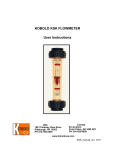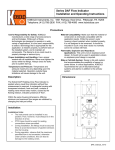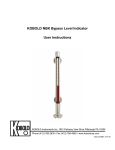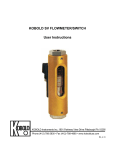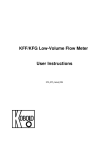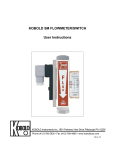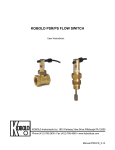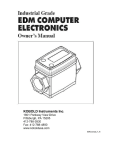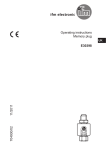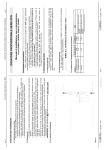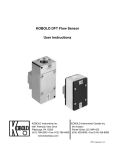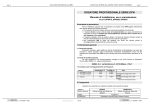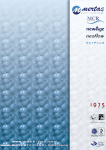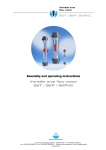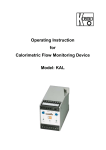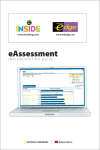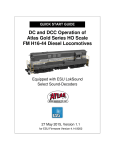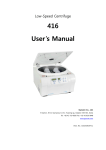Download Kobold KSM Series Flow Meters Manual PDF
Transcript
KOBOLD KSM FLOWMETER User Instructions USA 1801 Parkway View Drive Pittsburgh, PA 15205 PH 412-788-2830 Canada 9A Aviation Point Claire, QC H9R 4Z2 PH 514-428-8090 www.koboldusa.com KSM_manual_08-10 Table of Contents 1.0 General ............................................................................................. 1 2.0 Specifications ................................................................................... 1 3.0 Installation instructions...................................................................... 4 3.1 Mounting ................................................................................ 4 Operation .......................................................................................... 5 4.1 Reading the Flow Rate .......................................................... 5 4.2 Adjusting the Setpoints; KSM -5000/6000 ............................. 5 4.3 Operating the Setpoints; KSM -5000/6000 ............................. 5 5.0 Maintenance ...................................................................................... 6 6.0 Arrival of Damaged Equipment .......................................................... 6 7.0 Need Help With Your KSM ................................................................. 6 4.0 List of Diagrams Diagram 2.3 Switch Wiring Schematic ......................................... 2 Diagram 2.4 Dimensions & Pressure Loss .................................... 3 Table 2.1 Technical Data ............................................................... 1 Table 2.2 Material construction ..................................................... 2 Table 2.5 Reed Contacts - Technical Data ................................... 4 List of Tables 1 KSM KOBOLD KSM FLOWMETER User Instructions CAUTION: 1.0 For safety reasons, please read the cautionary information located at the end of the manual, before attempting installation. General The KOBOLD KSM flowmeter is a high volume flow measuring device, intended for applications in which the corrosion resistance of synthetic materials (plastics) is required. The KSM operates on the principle of the variable area flowmeter (float in a conical tube or rotameter). The KSM may be outfitted with a setpoint switch (reed type - 1 or 2 pc.) to allow control of external electronics by triggering upon flow rate changes. 2.0 Specifications Table 2.1; Technical Data Operating Principle: Variable area Dimensions: See Diagram 2.4 Display: Direct reading, calibrated for Water or Air at standard conditions (20°C, 0 PSIG Outlet) Range: See Diagram 2.4 Operating Temperature: 32° F to 140° F Maximum Internal Pressure: 145 PSIG FM Rev 08/10 KSM 2 Table 2.2; Materials of Construction Body: Trogamid-T or Polysulfone Float: KSM- X001 to KSM-X300 PVDF KSM-X600 PVC Float Stops: PVDF O-Rings: EPDM End Fittings: PVC Diagram 2.3: Switch Wiring Schematic FM Rev 08/10 3 KSM Diagram 2.4; Dimensions & Pressure Loss FM Rev 08/10 KSM 4 Table 2.5; Reed Contact - Technical Data Maximum Voltage: 230 VAC Maximum Current: 0.5 A Maximum Power: 10 W /12 VA Switch Hysteresis: 3-12 mm Maximum Ambient Temperature: 32° F to 130° F 3.0 Installation Instructions CAUTION: For safety reasons, please read the cautionary information located at the end of the manual, before attempting installation. NOTE: Before installation, remove any protective netting surrounding the float within the metering tube and discard. This netting is for shipping purposes only. 3.1 - Mounting The KSM is supplied with PVC end connectors and PVC cap nuts as standard. To install the instrument, simply: 1. Remove cap nuts and end fittings from your KSM. 2. Place cap nut over pipe to which you wish to connect. 3. Per manufacturer's instructions, use a PVC adhesive/solvent to glue fittings in place and let cure. 4. Fasten connectors to KSM with PVC nuts. Take care not to overtighten the nuts. If necessary, use a strap wrench on the nuts. Do NOT use a pipe wrench, pliers, or any other sharp instrument on the fittings, as this may compromise the strength, and eventual safety, of the instrument. Alternately, the KSM can be ordered with an optional NPT threaded fittings; alter the installation procedure accordingly. Use an appropriate thread sealant. NOTE: The KSM must be installed vertically (long axis), with the inlet at the bottom. FM Rev 08/10 5 4.0 KSM Operation We recommend that, if possible, the medium be introduced to the instrument in gradually increasing amounts. This procedure serves two basic functions: 1. It prevents oscillation of the float upon sudden introduction of media (particularlygases). 2. It prevents possible damage to the instrument caused by pressure surges (as described in the cautionary section). 4.1 - Reading the Flow Rate Flow rates measured by float type devices are typically read at the largest float diameter. In the case of the KSM, this is the top edge of the float. 4.2 - Adjusting the Setpoint; KSM...-5000/6000 series To adjust a setpoint: 1. Loosen the holding screw found on the setpoint indicator body, near the V-groove. 2. Slide the switch to the desired setpoint value. 3. Tighten the holding screw, taking care not to overtighten. 4. Verify desired operation with media flowing and adjust if necessary. 4.3 - Operating the Setpoints; KSM...-5000/6000 series Typical reed switch operation is as follows: The setpoint switch is actuated by the motion of the magnet-containing float past the switch position. The behavior of the switch is bistable - that is, the switch toggles from one state to the other whenever the float passes, and remains in that state until the float again passes back in the reverse direction. Since a reed switch is a switch in the purest sense, external electronics may be driven directly through it, provided that the electrical current/power loads are not demanding or excessive. (See Table 2.4 for reed switch performance data.) Should switching of currents or voltages in excess of the abilities of the reed switch be required, a suitable isolation relay must be installed. FM Rev 08/10 KSM 5.0 6 Maintenance The major enemy of float-type flowmeters is dirt. We recommend that clean or filtered media only, be passed through the device. If using the setpoint switch, it is particularly important to guard from contamination by ferritic (metal) materials. To protect from these, we suggest the installation of a magnetic filter, such as a KOBOLD MFR.., or equivalent. 6.0 Arrival of Damaged Equipment Your instrument was fully inspected prior to shipment and found to be defect-free. If damage is visible on the unit, we advise that you carefully inspect the packing in which it was delivered. If damage is visible, notify your local carrier at once, since the carrier is liable for a replacement under these circumstances. If your claim is refused, please contact KOBOLD Instruments for further advisement. 7.0 Need help with your KSM? Call one of our friendly engineers at 412-788-2830. FM Rev 08/10 7 KSM Caution PLEASE READ THE FOLLOWING GENERAL FLOW METER/ MONITOR WARNINGS BEFORE ATTEMPTING INSTALLATION OF YOUR NEW DEVICE. FAILURE TO HEED THE INFORMATION HEREIN MAY RESULT IN EQUIPMENT FAILURE AND POSSIBLE SUBSEQUENT PERSONAL INJURY. FM Rev 08/10 KSM 8 • Inspect instrument for damage upon arrival. Cracked, fractured, bent or otherwise damaged instruments must not be put into use, since the device is weakened to an unknown extent. (The operations and installation guide will explain how to make a claim on damaged instruments.) • Under NO circumstances must the maximum tolerances (temperature and pressure) be exceeded. • The maximum tolerances of the device have been determined using water, air and/or oil. If using other media, especially corrosive ones, it is critically important that the user determine chemical compatibility with our instruments. A list, detailing material composition of our instruments, is available from KOBOLD Instruments Inc. upon request. KOBOLD Instruments Inc. cannot accept responsibility for failure and consequences resulting from use of media other than water, mineral oil, air, and nitrogen. • Install the device in a fully supported position within your flow system. This avoids excessive stresses which may damage the instrument. In particular: a. Ensure that the plumbing leading to and from the instrument is fully supported and that the instrument does not perform the physical function of a joint. b. When calculating stress on the device caused by plumbing, the weight of the medium in the pipes must be considered as well. c. Misaligned runs of rigid piping can cause large stresses when connected to the instrument. Do not connect in such a fashion. • During installation, avoid stresses on the instrument by following guidelines given below: a. When connecting fittings, hold the instrument fittings rigid with a correctly sized wrench. Do not install by twisting the instrument into the pipe fittings. b. Do NOT install by holding the device housing to provide counter-torque to the pipe fitting. c. Use an appropriate amount of PTFE tape on male threads of fitting. This reduces the twisting stresses produced by tightening the fittings into each other. d. Do not use pliers or wrenches on the housing, as this may damage it. e. Do not overtighten, as this may fracture the fittings. FM Rev 08/10 9 • KSM During operation, there are a number of situations to avoid: a. The sudden cessation of fluid flow causes what is typically referred to as "water hammer". Most people are familiar with this phenomenon from their home experience - it is the cause behind the loud clank of water pipes which occurs when faucets are turned off too suddenly. The cause behind this "water hammer" is quite easy to visualize. Water is fairly massive. The amount of water in long runs of pipe is quite substantial. When the faucets are turned off suddenly, especially from a full on condition, the water has considerable momentum and does not want to stop flowing. The situation is similar to stopping a car by running into a wall, rather than by applying brakes. Both are sudden rather than gradual. The damage to the wall can be substantial (not to mention the car). The "water hammer" causes surges in fluid pressure which could cause the measurement instrument's pressure limit to be exceeded, resulting in failure and possible personal injury. b. Fluid surges, as well as the water hammer, can be particularly damaging to empty flowmeters since there is no back pressure in the device. The damage is caused, once again, by momentary excess pressure. To avoid these surges, fluid lines should remain full (if possible) and water flow should be introduced to the device slowly. c. If the instrument is isolated with inlet and outlet valves, the flowmeter must be completely drained when said valves are both closed. Failure to do so could result in damage to the device caused by thermal expansion of fluid. d. Freezing of water in the instrument must be avoided since the resultant expansion will damage the flowmeter and make it unsafe for use. FM Rev 08/10













